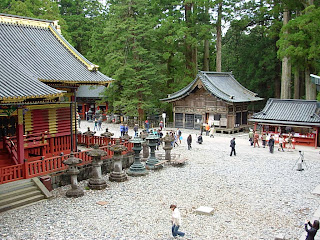We are quite familiar with
the three monkeys who teach us the maxim of “See no evil, Hear no evil,
and Speak no evil”. Mahatma Gandhi had popularized this monkey-trio in
India. He spread the message by living a life that was embodiment of these
noble principles.
It is believed that this
statue of three monkeys was gifted to Gandhiji by a group of Chinese visitors who
came to meet him at the Santhi Niketan. This small statue made of china clay marks
an exception to the principle of non-possession of the Mahatma.
The roots of the philosophy
of these monkeys lay in the ancient Sino-Japanese tradition. Great Chinese
philosopher Confucius once stated “Look not, listen not and speak not to what
is contrary to propriety”. This concept was introduced into Japan by a Buddhist
monk in 7th century A.D. Original teaching of Confucius had nothing
to do with monkeys. To illustrate these three principles three monkeys were
used in Japan. This monkey-representation was attributed to Hidari Jingoro, an
ancient Japanese artist, master-craftsman, and sculptor. He was believed to be a
legendary character with superhuman artistic talents.
The oldest and the most
famous wooden carving of these monkeys can be seen in the Toshogu Shrine in the
city of Nikko in Japan. Toshogu shrine is a Shinto Shrine where Tokugawa
Leyasu, the founder of the Shokugawa Shogunate (a feudal military government, which
ruled Japan for over 250 years) is enshrined as a deity.
Shinto is the ancient
religion in Japan like the Hinduism in India. The Toshogu shrine was built in
the year 1617 during the Edo period and at present it is protected as a UNESCO
World Heritage Site.
The carving of the three
monkeys appears in the stable of sacred horses of the shrine. The monkeys are
called Mizaru (who sees no evil), Kikazaru (who hears no evil) and Iwazaru (who speaks no evil). According
to tradition Hidari Jingoro did the breathtakingly beautiful carvings of the
“Three Monkeys”, and all other wooden carvings in the shrine, including the
most famous “Sleeping Cat”. Both these
carvings are now celebrated as “National Treasures of Japan”.
(Photographs by the author)
Fourth Monkey
There is a belief that in the
original Chinese tradition there used to be a “fourth monkey” also. In Japan
the fourth monkey is known as “shizaru”.
This representation of a fourth monkey is not commonly seen now. The fourth
monkey was missing even on Gandhiji’s table.
In China there is a fourth monkey
that stands for “not doing evil”. The Japanese Shizaru is illustrated as
covering its genitals with both hands. In a way, I find this most appropriate
since deviations in sex seem to be the root cause of many problems. I may sound
as though I am endorsing the Freudian theory. I am not.
Gandhi himself confided that
the most difficult battle to fight throughout his life was to overcome his own
demons, fears and insecurities. I try to understand these words of confession in
relation to what he had written about sex.
Gandhiji wrote in the journal
“Harijan” on March 28, 1936: “Sex urge is a fine and noble thing. There is
nothing to be ashamed of it. But it is
meant only for the act of creation. Any other use of it is a sin against God
and humanity”
I do not want to comment on
the above words of Mahatmaji. But I strongly believe that, in today’s India,
where the sex related crime against women has increased to an alarming level,
there is a real need for Shizaru, the
fourth monkey.

